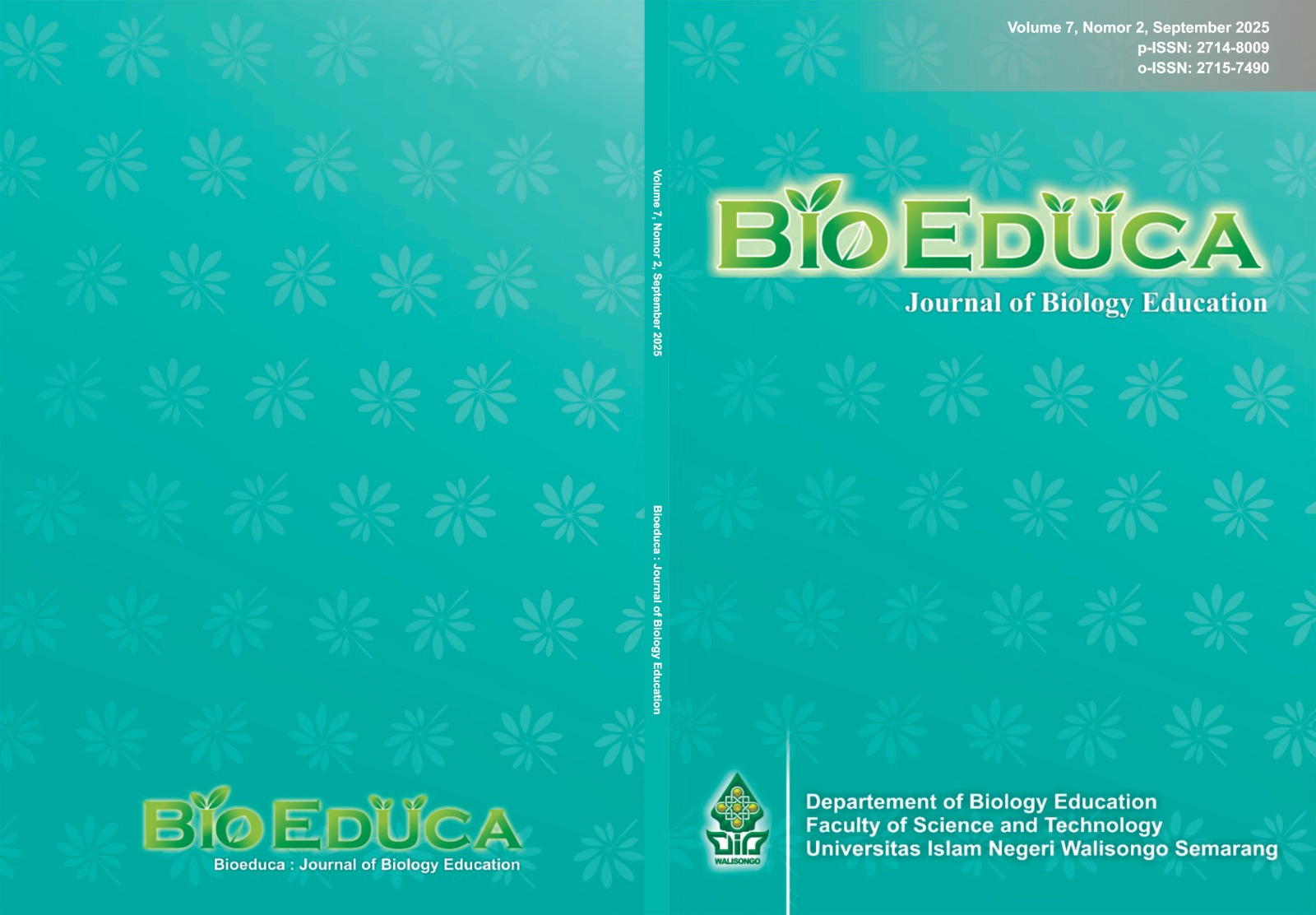Development of Bioinformatics Based E-Magazine for Medical Biotechnology Learning: a Case Study of In Silico Research Project
Main Article Content
Abstract
The rapid development of technology has led to digitalization in various fields, including education. In higher education, students are required to master technology according to their field of expertise. One of the technological applications for biology students is bioinformatics, which can be integrated into medical biotechnology learning through relevant media. This study aims to develop a bioinformatics-based e-magazine as a supporting medium for medical biotechnology learning. The research employed a Research and Development (R&D) method using the ADDIE model (Analyze, Design, Development, Implementation, Evaluation). The needs analysis involved 66 students, with all participants (100%) agreeing on the importance of developing a bioinformatics e-magazine. The e-magazine design was developed by incorporating the in silico research results of Moringa oleifera leaf compounds as potential agents against lung cancer. Expert validation showed feasibility scores of 91.25% (material) and 85.7% (media), both categorized as very valid. The practicality assessment by users obtained an average score of 89.8% (very practical). Meanwhile, the effectiveness test yielded an average N-Gain score of 0.9 (medium improvement) with an N-Gain percentage of 59.71% (fairly effective). Therefore, the bioinformatics e-magazine can be categorized as feasible, practical, and effective to support medical biotechnology learning.
Downloads
Article Details

This work is licensed under a Creative Commons Attribution-ShareAlike 4.0 International License.
The copyright of the received article shall be assigned to the journal as the publisher of the journal. The intended copyright includes the right to publish the article in various forms (including reprints). The journal maintains the publishing rights to the published articles. Authors are allowed to use their articles for any legal purposes deemed necessary without written permission from the journal with an acknowledgment of initial publication to this journal.

This work is licensed under a Creative Commons Attribution-ShareAlike 4.0 International License.
References
Aisyah Siregar, N., Royani Harahap, N., & Sari Harahap, H. (2023). Hubungan Antara Pretest dan Posttest dengan Hasil Belajar Siswa Kelas VII B Di MTS Alwashliyah Pantai Cirebon. Edunomika, 07(01), 2–3.
Amin, M. (2016). Perkembangan biologi dan tantangan pembelajarannya. Seminar Nasional Pendidikan Dan Saintek, 2016, 1–11.
Amiruddin. (2021). Jejak-jejak praktik baik sang pengajar. Tangerang Selatan: Pascal Book PT. Mediatama Digital.
Arikunto, S. (2013). Prosedur penelitian: Suatu pendekatan praktik (Cet. 15). Jakarta: Rineka Cipta.
Branch, R. M. (2009). Instructional design: The ADDIE approach. Springer.
Diantari, L. P. E., Damayanthi, L. P. E., Sugihartini, N. S., & Wirawan, I. M. A. (2018). Pengembangan E-Modul Berbasis Mastery Learning Untuk Mata Pelajaran KKPI Kelas XI. Jurnal Nasional Pendidikan Teknik Informatika (JANAPATI), 7(1), 33. https://doi.org/10.23887/janapati.v7i1.12166
Diwanata, B., Rohman, F., & Munzil. (2021). PENGEMBANGAN MOBILE APPS KEANEKARAGAMAN BURUNG BERBASIS PJBL DAN EFEKTIVITASNYA PADA KEMAMPUAN LITERASI BURUNG MAHASISWA. Jurnal Pendidikan Biologi, 12(3), 158–163.
Fanani, M. Z. (2020). Pengembangan Kurikulum Berbasis Kerangka Kualifikasi Nasional Indonesia (KKNI) Program Studi S1 Manajemen Pendidikan Islam Fakultas Tarbiyah IAIN Kediri Untuk Meningkatkan Mutu dan Daya Saing. Journal of Islamic Education Management (JoIEM), Vol. 1 No., 1–28.
Hastini, F., & Tanjung, I. F. (2022). Pengembangan Majalah Biologi (Biozine ) Terintegrasi Nilai-Nilai Islam Pada Materi Bioteknologi. Jurnal Pembelajaran, 8(2), 317–329.
Husein IM, M. S., & Rusimamto, P. W. (2019). Pengembangan Trainer Smart Traffic Light Berbasis Mikrokontroller Arduino Pada Mata Pelajaran Sistem Kontrol Terprogram Di Smk Negeri 1 Cerme. Jurnal Pendidikan Teknik Elektro, 9(1), 105–111. https://ejournal.unesa.ac.id/index.php/jurnal-pendidikan-teknik-elektro/article/view/30819
Kintoko, K. (2017). Problem-Based Interactive Media on Circle’S Tangent By Using Adobe Flash Cs6. Daya Matematis: Jurnal Inovasi Pendidikan Matematika, 5(3), 399. https://doi.org/10.26858/jds.v5i3.4847
Lesk, A. M. (2019). Introduction to bioinformatics (5th ed.). Oxford University Press.
Perdani, H. N., & Azka, R. (2019). Teknologi Dan Pembelajaran Matematika Generasi Milenial. Proseding Sendika, 5(1), 508–514.
Putri, R. R., Muhaimin, & Syahri, W. (2017). PENGEMBANGAN e-MAGAZINE PADA MATERI LARUTAN ASAM DAN BASA UNTUK SISWA KELAS XI MIPA DI SMAN 1 KOTA JAMBI. FAKULTAS KEGURUAN DAN ILMU PENDIDIKAN UNIVERSITAS JAMBIUNIVERSITAS JAMBI, 634.
Rahadian, D. (2017). Teknologi informasi dan komunikasi (tik) dan kompetensi teknologi pembelajaran untuk pengajaran yang berkualitas. Jurnal Teknologi Pendidikan Dan Pembelajaran, 2(1), 234–254.
Riduwan. (2007). Skala pengukuran variabel-variabel penelitian. Bandung: Alfabeta.
Rohmah, A., Saputra, H. J., & Listyarini, I. (2020). PENGEMBANGAN E-MAGAZINE BERBASIS ANDROID DALAM PEMBELAJARAN KELAS V SEKOLAH DASAR. Elementary School, 7(02), 290–296.
Sari, A. P. P., Amin, M., & Lukiati, B. (2017). Buku Ajar Bioteknologi Berbasis Bioinformatika Dengan Model Addie. Jurnal Pendidikan , 2(6), 768–772.
Sari, D. W., & Muhammad Iqbal Filayani. (2022). Bioeduca: Journal of Biology Education. Bioeduca: Journal of Biology Education, 4(2), 1–11.
Srikandi, N., Putra, I. A., Ayu, N., & Pertiwi, S. (2019). DIFFRACTION: Journal for Physics Education and Applied Physics Majalah Elektronik Materi Rambatan Kalor untuk Meningkatkan Minat Belajar Peserta Didik. Journal for Physycs Education and Applied Physics, 2(1), 1–8.
Sugiyono. Metode Penelitian Kuantitatif, Kualitatif, dan R&D. Bandung Alfabeta, 2006
Sukarelawan, M. I., Indratno, T. K., & Ayu, S. M. (2024). N-Gain vs Stacking. Surya Cahya, 53.
Syita, A. R., Shofiyah, I., Putri, Y. E., & Afnani, M. R. (2025). Pengembangan E-Modul Bioinformatika Berbasis Program Based Learning (PBL) Tentang Prediksi Interaksi Senyawa Aktif Daun Pepaya Sebagai Kandidat Obat Kanker Paru-Paru. Otus Education: Jurnal Biologi Dan Pendidikan Biologi, 3(1), 1–12. https://doi.org/10.62588/otusedu.2025.v3i1.0243
Zulkipli, Zulfachmi, & Rahmad, A. (2024). Alasan Peneliti Menggunakan Analisis Statistik Wilcoxon (Non Parametrik). Prosiding Seminar Nasional Ilmu Sosial Dan Teknologi (SNISTEK), 6, 119–125.

